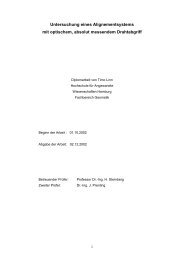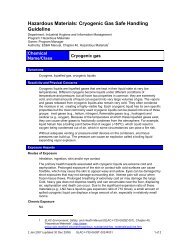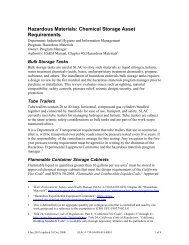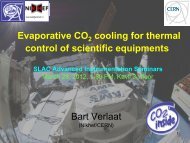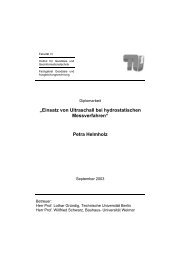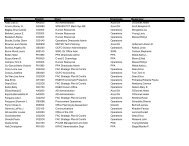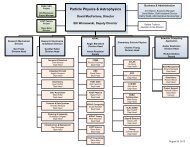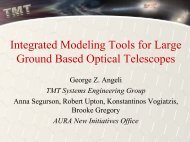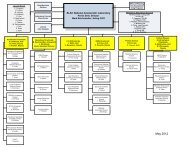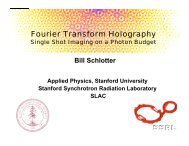BES - SLAC Group/Department Public Websites - Stanford University
BES - SLAC Group/Department Public Websites - Stanford University
BES - SLAC Group/Department Public Websites - Stanford University
You also want an ePaper? Increase the reach of your titles
YUMPU automatically turns print PDFs into web optimized ePapers that Google loves.
FYO7 <strong>SLAC</strong> S CIENCE AND T ECHNOLOGY S ELF E VALUATION<br />
London, David A. Shapiro, Center for Biophotonics Science and Technology, <strong>University</strong><br />
of California, Davis; David van der Spoel, Florian Burmeister, Magnus Bergh, Carl<br />
Caleman, Gösta Huldt, Marvin Seibert, Filipe R. N. C. Maia, Richard W. Lee, Abraham<br />
Szöke, Nicusor Timneanu, Laboratory of Molecular Biophysics, <strong>Department</strong> of Cell and<br />
Molecular Biology, Uppsala <strong>University</strong>; Elke Plönjes, Marion Kuhlmann, Rolf Treusch,<br />
Stefan Düsterer, Thomas Tschentscher, Jochen R. Schneider, DESY, Eberhard Spiller,<br />
Spiller X-ray Optics, Livermore, California ; Thomas Möller, Christoph Bostedt, Matthias<br />
Hoener, Institut für Optik und Atomare Physik, Technische Universität Berlin.<br />
N OTEWORTHY P RACTICES<br />
Ultrafast Summer School<br />
This summer school provided an important means by which PULSE can provide leadership in future<br />
scientific directions associated with ultrafast science.<br />
High Harmonics<br />
We concentrate on the relation between the electronic orbitals of the molecules and the emitted high<br />
harmonic amplitude and phase, for which we established novel measurement schemes with a<br />
reference radiator. The information can be used to image the molecular orbitals.<br />
CEP<br />
We would like to invest more energy in the future to gain more control over the pulse shape on one<br />
hand, and create single attosecond pulses instead of a train on the other hand. We plan to attack the<br />
first aim by writing specific electronic, vibrational and rotational coherence on the molecule by<br />
visible and UV light that can all be used to control the attosecond pulse shape. The second approach<br />
can be achieved by using few cycle pulses and combining them with spectral selection in the<br />
attosecond pulse spectrum or by use of polarization gating in the generation process. The attosecond<br />
science will also have a tremendous impact on LCLS research, as stated above. The production of<br />
CEP locked pulses in the few cycle regimes is necessary to produce well defined pulses below 1 fs<br />
from LCLS. We are training people in this lab on technological and scientific issues of attosecond<br />
science before LCLS has started to run.<br />
Magnetic Nanostructures<br />
Recently we found a way to numerically simulate the possible switching processes and mapped the<br />
simulations to experimental data. This leads to a unified picture of magnetization reversal by spin<br />
injection. The different nonuniform states can be described by magnetic vortex cores that are either<br />
real inside the samples or virtual outside the sample. The motion of these vortex cores describes the<br />
switching mechanism and switching dynamics. Analytic calculations show that magnetization<br />
reversal by spin injection amplifies magnetic nonuniformities.<br />
O PPORTUNITIES FOR I MPROVEMENT<br />
Attoscience<br />
Almost all experiments so far used the attosecond streak camera idea: electrons are emitted by an<br />
attosecond pulse and gain kinetic energy in an overlapped strong IR field. The electron energy can be<br />
correlated to their time of birth, and such a time trace of electron emission can be constructed. The<br />
technique is applicable to diluted gases and surfaces only. It will therefore be important for the future<br />
of attoscience to get a broader range of experimental schemes.<br />
High Harmonics<br />
In the future we will work on more complicated molecules that can undergo a prototype chemical<br />
process in passing a CI between different electronic states. High harmonic imaging will be an ideal<br />
tool to follow very fast changes in the electronic orbitals. In all those studies, we are already<br />
generating trains of attosecond pulses, and since they are generated in molecules, they are shaped in<br />
amplitude and phase.<br />
F I N A L P A G E 2 3



